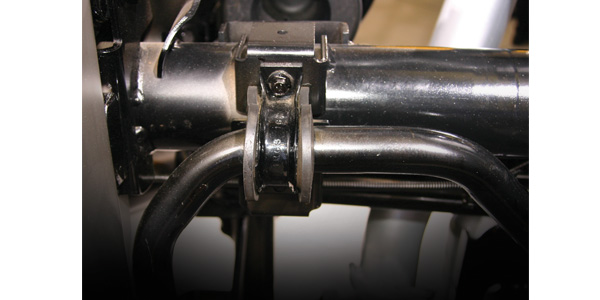
Sway bar bushings are small but important suspension components that are easily diagnosed and easily replaced, yet a surprising number of vehicles have either missing or worn-out sway bar components. The sway bar helps combat body roll in corners, and helps keep the wheels planted firmly on the asphalt. In order to effectively maintain handling, the sway bar must be anchored to the frame, as well as at either end of the bar, near the wheels. Like many other suspension components, sway bars are anchored in place with bushings, which allow a limited range of motion without the need for bearings or other moving parts.
Sway bar bushings may be made of natural or synthetic rubber, or even polyurethane materials. Polyurethane is a popular choice among performance enthusiasts, because the material is stiffer than rubber, and also is more resistant to heat, ozone, and the various automotive fluids that can degrade rubber components over time. Polyurethane’s rigidity helps reduce the “slop” that develops when using rubber bushings, which eventually compress and/or shrink, leaving small gaps between the sway bar and the bushing, as well as between the bushing and its retainer strap. These gaps allow for the tell-tale clunking that is often the first noticeable symptom of bad bushings.
Installation of sway bar bushings is usually a breeze, since most manufacturers offer “split” bushings for ease of installation. For those bushings without a split design, a little bit of elbow grease is required to slip the bushing over the end of the bar and locate it properly near the center of the bar. Aside from elbow grease, most of these bushings require no lubricant, and using a petroleum-based lubricant to prevent “squeaks” can actually soften and damage rubber bushings, reducing their effectiveness and service life. Some manufacturers recommend using a silicone or water-based lube, or even vegetable oil to ease installation of bushings with tight tolerances. These lubricants do not react with the bushing material, and eventually wash away without leaving any residue. Polyurethane bushing manufacturers often specify their own proprietary lubricants, and even offer retainer straps with grease fittings for periodic maintenance. If a set of bushings does not come with a lubricant, or instructions to use a lubricant, then they should be installed dry.
One of the most difficult aspects of selling sway bar bushings is determining the size of the bushing required for the application. The diameter of the sway bar helps determine the torsional rigidity of the bar, and the amount of roll control the twisting motion of the bar can dampen. Different handling packages can have different bar diameters, leaving the parts specialist to choose from several different options, usually catalogued by bar diameter. While this is easily determined with the use of a dial caliper, many of our customers are not equipped with this essential parts counter tool. However, almost everyone, DIY or professional, owns an adjustable “Crescent” wrench. Adjust the jaws to fit snugly around the bar, and then transfer this measurement to a tape measure to find the correct sizing. Some adjustable wrenches even have measurements etched into the jaws. Customers with well-stocked toolboxes may also be able to use their combination wrenches as “go, no-go” gauges to find the correct diameter of their sway bar.







